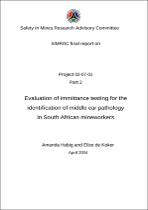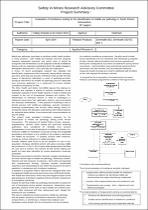 ResearchSpace
ResearchSpace
Evaluation of immittance testing for the identification of middle ear pathology in South African mineworkers.
JavaScript is disabled for your browser. Some features of this site may not work without it.
- ResearchSpace
- →
- Research Publications/Outputs
- →
- Conference Publications
- →
- View Item
| dc.contributor.author |
Habig, A

|
|
| dc.contributor.author |
De Koker, E

|
|
| dc.date.accessioned | 2007-10-09T12:34:03Z | |
| dc.date.available | 2007-10-09T12:34:03Z | |
| dc.date.issued | 2004-04 | |
| dc.identifier.citation | Habig, A and De Koker, E. 2004. Evaluation of immittance testing for the identification of middle ear pathology in South African mineworkers. Safety in Mines Research Advisory Committee, SIM 020701, April, 2004, pp 1-67 | en |
| dc.identifier.uri | http://hdl.handle.net/10204/1306 | |
| dc.description | This report consists of 2 papers: report summary & Main Content | en |
| dc.description.abstract | The study evaluated immittance measures, specifically tympanometry and acoustic reflex testing, for the identification of middle ear pathology among South African mineworkers. The outcomes of medical history reviews, otoscopy, tympanometry, acoustic reflex testing and pure-tone screening audiometry were considered for 181 gold mine workers, within the context of the employer’s medical surveillance programme for noise-induced hearing loss (NIHL). Different screening procedures were compared with regards to the ability to identify middle ear problems Acoustic reflexes were found to be too sensitive for use in this population. Otoscopy identified 49.7 per cent of workers as having active or previous middle ear problems while tympanometry identified 27.1 percent of workers. The workers all had normal hearing and would not have been identified by normal audiometric screening procedures. | en |
| dc.language.iso | en | en |
| dc.subject | SIMRAC | en |
| dc.subject | SIM 020701 | en |
| dc.subject | Immittance testing | en |
| dc.subject | Middle ear pathology | en |
| dc.subject | Tympanometry | en |
| dc.title | Evaluation of immittance testing for the identification of middle ear pathology in South African mineworkers. | en |
| dc.type | Conference Presentation | en |
| dc.identifier.apacitation | Habig, A., & De Koker, E. (2004). Evaluation of immittance testing for the identification of middle ear pathology in South African mineworkers. http://hdl.handle.net/10204/1306 | en_ZA |
| dc.identifier.chicagocitation | Habig, A, and E De Koker. "Evaluation of immittance testing for the identification of middle ear pathology in South African mineworkers." (2004): http://hdl.handle.net/10204/1306 | en_ZA |
| dc.identifier.vancouvercitation | Habig A, De Koker E, Evaluation of immittance testing for the identification of middle ear pathology in South African mineworkers; 2004. http://hdl.handle.net/10204/1306 . | en_ZA |
| dc.identifier.ris | TY - Conference Presentation AU - Habig, A AU - De Koker, E AB - The study evaluated immittance measures, specifically tympanometry and acoustic reflex testing, for the identification of middle ear pathology among South African mineworkers. The outcomes of medical history reviews, otoscopy, tympanometry, acoustic reflex testing and pure-tone screening audiometry were considered for 181 gold mine workers, within the context of the employer’s medical surveillance programme for noise-induced hearing loss (NIHL). Different screening procedures were compared with regards to the ability to identify middle ear problems Acoustic reflexes were found to be too sensitive for use in this population. Otoscopy identified 49.7 per cent of workers as having active or previous middle ear problems while tympanometry identified 27.1 percent of workers. The workers all had normal hearing and would not have been identified by normal audiometric screening procedures. DA - 2004-04 DB - ResearchSpace DP - CSIR KW - SIMRAC KW - SIM 020701 KW - Immittance testing KW - Middle ear pathology KW - Tympanometry LK - https://researchspace.csir.co.za PY - 2004 T1 - Evaluation of immittance testing for the identification of middle ear pathology in South African mineworkers TI - Evaluation of immittance testing for the identification of middle ear pathology in South African mineworkers UR - http://hdl.handle.net/10204/1306 ER - | en_ZA |






